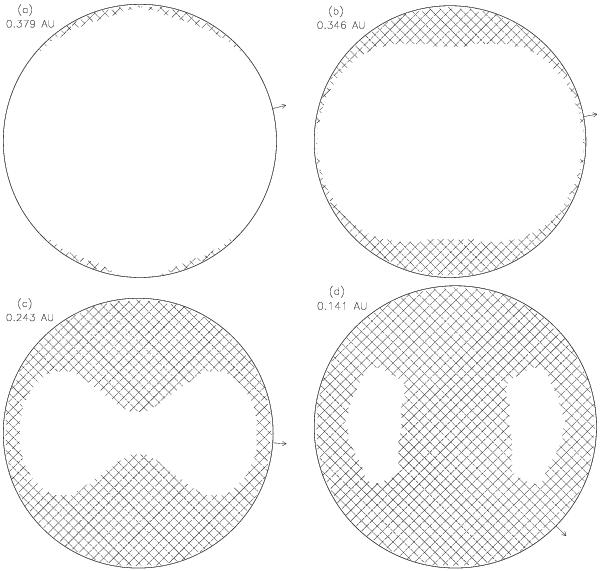Fig. 2

Propagation of a damaged volume, where the thermal stress exceeds the material strength (dashed areas), inside a meteoroid approaching the Sun. We show here the situation in the meridional plane with the spin pole (λ = 0°, β = 45°) pointing up and use the homogeneous-body model from CV1 for simplicity (because the time-dependent part of the stress field is pushed to a very small surface shell, not seen in this resolution, the global stress field in the body is roughly axisymmetric and accurately approximated by the zonal part of the stress field). The 10-cm size meteoroid was placed on a Geminid-stream orbit and assumed to have the thermal and mechanical parameters of carbonaceous chondrites. At large heliocentric distance, the damaged zone first takes a shape of polar caps (top and left panel a)), which then propagate more deeply into the body. At a distance of 0.35 AU from the Sun, the fractured volume has a shape of a near-spherical shell, which is thicker at the poles (top and right panel b)). Closer to the perihelion, bottom panels, the damaged zone takes a more complex shape. However, when the previously developed surface insulating layer begins to thermally shield the core (used in Sects. 4.1 to 4.3), the damaged zone will stop propagating deeper to the center. The arrows indicate the direction toward the Sun.
Current usage metrics show cumulative count of Article Views (full-text article views including HTML views, PDF and ePub downloads, according to the available data) and Abstracts Views on Vision4Press platform.
Data correspond to usage on the plateform after 2015. The current usage metrics is available 48-96 hours after online publication and is updated daily on week days.
Initial download of the metrics may take a while.


